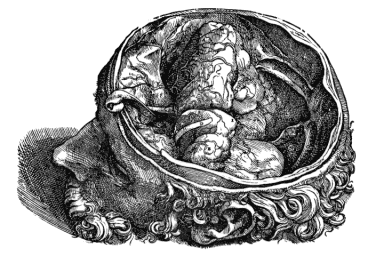Vesalius' Wood Blocks
Today, I touch history -- just as it slips away. The University of Houston's College of Engineering presents this series about the machines that make our civilization run, and the people whose ingenuity created them.
The director of the new Burndy Library at MIT leads me through her great vault of not-yet-cataloged books. The scholar-industrialist Bern Dibner amassed this huge set of rare books while he lived. They've just recently been relocated at MIT.
Here are many of the first illustrated books, from the near wake of Gutenberg. Here's the personal library of the great 19th-century physicist John Tyndall. I savor treasure after treasure. The woman stops by a shelf and says, "This'll interest you." She opens a box full of snowy white paper. I'm stunned by what I see on the paper. These are original Vesalius illustrations.
Andreas Vesalius was a young doctor who completely changed the direction of medicine in 1543 with a magnificent anatomical study of the human body. Four hundred and fifty years ago, his pictorial studies took anatomy out of the realm of scholastic speculation and put it under the lens of objective observation.
But these prints are nearly new. I'm puzzled -- disoriented. Then I learn the sad story behind them. Vesalius published two editions before he died. First his heirs took the wood blocks. Then the blocks vanished from our records for over two centuries.
They surfaced in Augsburg when a printer got hold of them and printed a few plates in 1706 and 1723. By 1783 they were in Ingolstadt. An incomplete set showed up in a Munich cupboard in 1893. In 1932 that set mysteriously proved to be nearly complete.
Only a few small pieces were missing along with the frontispiece -- a great macabre picture of Vesalius himself in a 16th-century operating theatre, cutting into the belly of a dead woman. That block is at the University of Louvain, in Belgium.
So, in 1934, this new set of Vesalius's original pictures -- this set I hold in my hands -- was printed. "What's the date for these pictures?" I ask the director. "Are they 60 years old or 450?" "Ink hit the paper in 1934," she says, "They're 60 years old." Maybe! But I feel centuries here -- not just decades.
The pictures were cut into pear wood, sawn parallel with the grain. It was exquisite work. The carver copied drawings of Vesalius's dissections, probably made by a student of Titian. The blocks are very durable -- good for thousands more copies.
A great early-20th-century doctor, Harvey Cushing, wrote about Vesalius's wood blocks in 1942, during WW-II:
Time alone will tell what in another four centuries may happen to these wood/blocks. . . . Let us hope that by 2342 AD peace and goodwill among the nations will have come to stay.
I said at the start that this would be a sad story. Well, it is. Vesalius's blocks, which had changed medical history, perished soon after that -- destroyed, once and for all, by allied bombs.
I'm John Lienhard, at the University of Houston, where we're interested in the way inventive minds work.
(Theme music)
Wiegand, W., Marginal Notes by the Printer of the Icones. Three Vesalian Essays: to Accompany the Icones Anatomicae of 1934. New York: The Macmillan Co., 1952.
Cushing, H., A Bio-Bibliography of Andreas Vesalius. New York, Schuman's, 1943, p. 108.
Saunders, J.B. deC. M. and O'Malley, C.D. The Illustrations from the Works of Andreas Vesalius of Brussels. New York: Dover Publications, Inc., 1973, p. 10.
O'Malley, C.D., Andreas Vesalius of Brussels: 1514-1564. Berkeley: University of California Press, 1965.
I am most grateful to Christine Ruggere (Director) and to Frederic F. Burchsted, both at the Burndy Library at MIT, for showing me the 1934 Vesalius prints and for providing documentation and advice.
For more on Vesalius, see Episode 325

One of the Block Prints from Vesalius's De Humani Corporis Fabrica Libri Septum, 1543